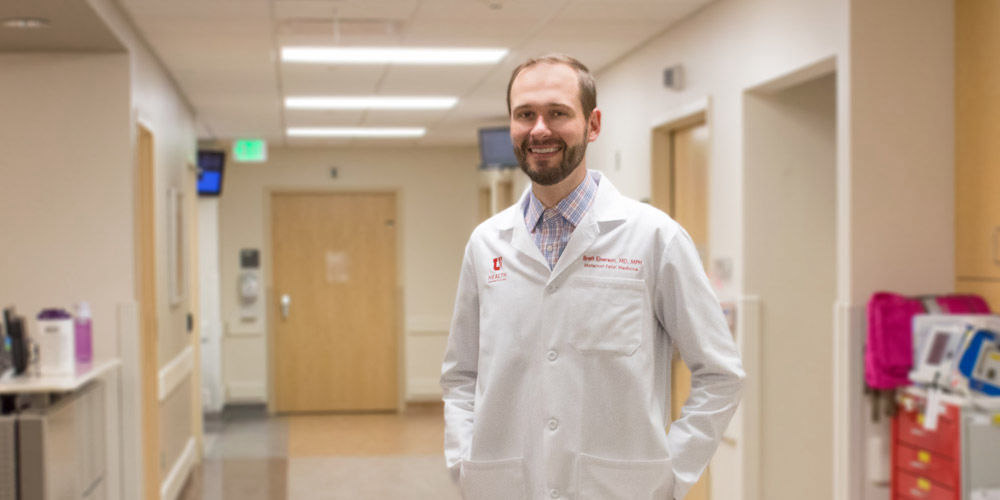True Grit:
Einerson’s determination reminded us of Angela Duckworth’s Grit: The Power of Passion and Perseverance. When you believe in the purpose of your work and invest in deliberate improvement, long-term success is possible.
work is meaningful. I gravitate to situations where I get to serve as a navigator for women experiencing high-risk pregnancies and making really hard decisions about their families and their health. I’m guiding people through a land they’ve never been through. It’s engaging and inspiring.
I see my role as laying out a map for people who don’t have one. I want to help them walk into this valley and come out the other side with a decision about how they’re going to deal with what could be a devastating piece of news.
My patients enter the room without any expectations other than that their world is going to be completely different when they leave. It’s heart-wrenching and difficult—but totally worth it. The relationship aspect is really important to me. The cards on my wall from patients are as important to me as the degrees.
Working as a team reduces uncertainty
We have a perception that health care efficiency, good care, and patient satisfaction are diabolically opposed forces. But they’re not. Patient satisfaction is more than just being nice to people. Fundamentally, patient experience is about reducing uncertainty for people.
As a patient, you’re overwhelmed by your medical issue, but also by the bureaucracy of the system. I’m excited to develop a systematic way to come up with solutions to problems that everybody knows need to be solved, but nobody has the energy, resources, or organization to solve.
As clinical head of our value stream initiative, my job is to ask people to think big about how the system should be changed to function more efficiently. People find that engaging. Nurses who’ve worked here for years—Bernice Tenort, Nikole Ihler, Janet Fisher, Colleen Ferrin, Stacy Wilkins—their eyes light up and they say, “I know exactly what we need to do.” It’s pent-up energy. They’re ready to contribute. Everybody has ideas, and the process that we engage in gives people a formalized way of voicing those ideas.
My question is, how do we get all the stakeholders—patients, nurses, residents, unit clerks, attending doctors, value engineers, administrators—under one banner to change things? To really improve the lives of patients while at the same time reducing the cost of health care?
Sub-optimal care is often a system issue
During my second year of medical school at Wake Forest University, I became very interested in doctors who were asking difficult questions about the health systems in which they were working. I was really inspired to think about how we can improve this system to make it better for patients.
When you see injustices, inequality, or sub-optimal care delivered to patients, it’s not always the nurse, doctor, or clerk messing up. Many of the problems that plague health care are system issues. The docs that engaged me in my clinical year were the docs taking great care of patients but also asking difficult questions about the health system and how they could improve it.
System work provides a megaphone for increased impact
How do we improve health for people on a grander scale—say one to one million—rather than just the one-on-one doc-patient relationship? After medical school, I took a year off in 2010 and got my master’s in public health at University of North Carolina. That was the year the Affordable Care Act was being crafted, fought over, revised, and finally passed. It was a fascinating year to sit in classes with people engaged in discussions about how to make our health system better.
I emerged from that year with a better understanding of how to do research but also a keen eye toward understanding difficult questions that need to be asked of our system. It invigorated me to embark on an academic career that involved asking those questions. Since that time, I’ve tried to put myself in positions of finding people (like those original people who inspired me in medical school) who are thinking about cost, value, systems, and how to improve. I’m especially interested in how we can think about cost more intensely and systemically.
Meaningful work is taxing, but also exciting
It’s a balance: being present for my patients while not being so emotionally spent that I can’t be a good dad and good husband at home. That’s why OB/GYN was ideal for me. What I do matters: I’m delivering babies, helping women make decisions about their pregnancies, and helping women get treatment for things they find embarrassing. It’s really exhilarating. I don’t think I would be as excited to go to work every day if there weren’t opportunities to get emotionally, psychologically, and intellectually involved in the care of patients.
People here at the University of Utah Health understand that health care is complex. We have an eye for quality and cost improvement in a way you don’t see in other big bureaucratic academic institutions. At the other places I’ve worked, I witnessed a lot of top-down thinking. Here at Utah, it feels more organized at the grassroots.
This article was first published April 5, 2019.
Brett Einerson
Hospitalist Ryan Murphy and Value Engineer Luca Boi outline four questions to address at the outset of any improvement.
In an organization as big as U of U Health, it’s hard to know where our work fits into the big picture. System Planning Manager Cassandra Taft highlights five ways teams can meaningfully contribute to Operational Plan priorities, regardless of job role or responsibility.
In her five years at University of Utah Health as hospitalist, educator, and medical director of AIM-A and WP5, Karli Edholm led amazing amounts of impactful work. She trained future leaders and improved the safety, experience, and cost of an inpatient stay. Here she shares her lessons for leading and staying focused on improvement: start with your own frustration.
